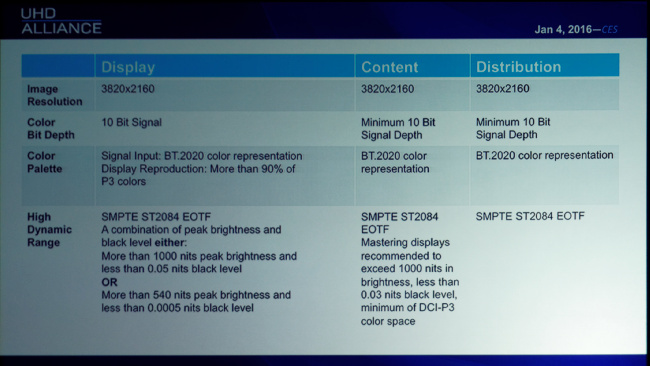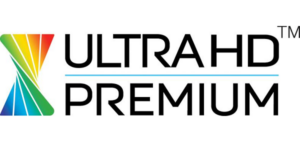Unusually, the UltraHD Alliance held a press event late on the evening of the first press day at CES, but we went along anyway. Despite the relaxation (mostly liquid!) at the CES Unveiled event and jetlag, we managed to stay awake! We followed up with a meeting in the Westgate with Victor Matsuda of Sony.
The event began with an explanation of the aims of the UltraHD Alliance (briefly, to ensure that content and devices are aligned to deliver a quality experience to consumers – see UltraHD Alliance Wants to Bring Order to the “Wild Wild West”, when we interviewed the Alliance at IBC), and the panel described how positive they are about the development. Given that all of the panel were from the content business and are looking forward to selling more of their content through packaged media and OTT, that was not a great surprise.
The two key announcements at the event were the details of the new logo and the agreed technical specifications for mastering and viewing content. The logo is shown here. However, there was quite a lot of discussion about the specification details among attendees at the press event.
 There is no suprise to the resolution, of course, although when we asked about the definition of resolution, it was clear that this has not been discussed. (That could mean quite a bit of controversy over the use of RGBW panels – Man. Ed.). Colour depth is also likely to be non-controversial, as high end sets have no problem with 10 bit. Hollywood is using 16 bits, anyway, so there is no problem with content. Again, there could be some controversy over bit depth on the panel, but, frankly, it would be hard to measure.
There is no suprise to the resolution, of course, although when we asked about the definition of resolution, it was clear that this has not been discussed. (That could mean quite a bit of controversy over the use of RGBW panels – Man. Ed.). Colour depth is also likely to be non-controversial, as high end sets have no problem with 10 bit. Hollywood is using 16 bits, anyway, so there is no problem with content. Again, there could be some controversy over bit depth on the panel, but, frankly, it would be hard to measure.
Turning to colour, a number of informed people that we spoke to were disappointed that the gamut requirement is just 90% of P3 and not the full P3 gamut, as there is going to be quite a lot of content available with 100% of P3, as movie makers creating digital content have been supporting it. The use of BT2020 colour encoding was broadly endorsed at the show, as it should make later support of a full 2020 gamut simpler.
The decision to support dual options in HDR are simply the recognition that while LCD can support high brightness, OLEDs can’t. The high black level for the 1,000 nits option is, again an acknowledgement that LCD can’t do much better. However, the limited peak brightness in OLED was seen as a disappointment, especially as LG Display was saying at CES that it could support 800 cd/m² peak brightness.
Analyst Comment
We met with Victor Matsuda of Sony and had some discussion about the issues of the new announcement. We tried to get more detail of the specifications and testing procedures, but these are not being made public at the moment. They could make or break this initiative. For example, we asked about the measurement of brightness. It seems that there is “nothing special” in the measurement of HDR, the black level number is a simple measurement of a black screen. That is why the requirement is stated as a black and white level, not as a contrast ratio, as this might depend on the measurement method.
We are continuing to try to get more understanding of the test methods.
Another area of concern is the 90% of P3. It seems that even this was a tough battle between the various interested parties in the Alliance. In our discussion, Matsuda also said that one of the key barriers to adopting a wider gamut was the increase in power consumption that might ensue from going for more saturated primaries.
Our Display Daily team was at the press event and Chris Chinnock, if I remember correctly, suggested that there might be a “stretch target” for the logo. This would act like the US Energy Star or EU energy ratings. With these ratings, at the time of publication, a new level was set for some years ahead. That ensures that the same logo or grading continues to reflect a genuinely premium experience. If this strategy is not adopted, within a few years, the logo would be so widely available that it might lose value.
We raised this idea with Matsuda, and it was clear that this had not been considered – there has been a huge effort to get this far, so might go into the thinking for the future. We also asked about the idea that the Premium brand was not very premium if Samsung could announce immediately that all its 2016 SUHD TVs would meet the logo requirements (which it did at its press conference). Matsuda said that it is important to remember that SUHD might be only just a “double digit” percentage of all Samsung’s UltraHD set sales.
We also asked about the OLED/LCD differences. Matusuda told us that the numbers were set after considerable user testing and even at the lower OLED brightness, many viewers preferred the technology and viewed it as good HDR.
After the initial announcement, I was very cynical about this logo as it looked to me that Hollywood and set makers seemed to have colluded to make the requirements the minimum that they could get away with. However, after discussions with the Alliance and representatives of member companies that I talked with during the show, I do accept that the bar for performance is probably as high as it could be at the moment, but I would dearly love to see a “stretch” target for 2019 or 2020. (BR)
During CES Glenn Derence, director of content development at US consumer body Consumer Reports, raised the question of why TV manufacturers were showcasing 8k TVs, when UltraHD sets are still not fully part of the public consciousness.
The UHD-A was formed last year to promote the benefits of UltraHD technology, and – in part – to help consumers understand what represents an UltraHD TV. The UltraHD Premium logo is an example, he said, of something that “pretty much guarantees that if you buy a TV with that label, you’re getting a fancy set with all the bells and whistles that will work with most of the content for the foreseeable future”.
Derence bemoaned the showing of 8k sets – which will be launched this year, according to some makers – alongside the UltraHD units. His argument was that confused the messaging around the format, as well as “hinting at the obsolescence to come”. Manufacturers should be very wary of this; delayed purchasing is a real danger in the fast-moving technology industry.
“Many of us have made our peace with frequent product turnover when it comes to smartphones and computers”, Derence continued. “Apple, LG, and Samsung release new flagship phones each year that promise new and revolutionary functionality. But TVs are supposed to be different… Predictability trumps innovation. Once you’ve got your TV working right, you don’t want to have to think about it for a while – a long while”. (TA)

